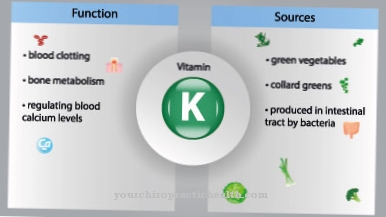Under the medical term Steatohepatitis the doctor calls fatty liver. This is due to the fact that unhealthy lifestyle habits stimulate fat production in such a way that the fats produced are stored in the liver cells. However, steatohepatitis is relatively easy to reverse.
What is steatohepatitis?

In the case of steatohepatitis, the attending physician speaks of a fatty liver. A distinction is primarily made between alcoholic and non-alcoholic steatohepatitis. In most cases, with a few lifestyle changes, a fatty liver can be reversed.
The doctor divides steatohepatitis into three grades. Grade 1 is referred to as a light or mild fatty liver, with less than a third of the existing cells storing fats. Grade 2 is a moderate fatty liver in which around two thirds of the liver cells are filled with fat. If the patient suffers from grade 3 fatty liver, the obesity affects more than two thirds.
causes
There are many, relatively different, causes. First, the doctor differentiates between alcoholic and non-alcoholic steatohepatitis. In the event of excessive alcohol consumption, the active ingredients damage liver cells, such as the cell membrane.
If there is a non-alcoholic fatty liver, the cause is often the metabolic syndrome.This means that type II diabetes mellitus, severe obesity or drugs such as poisons are responsible for steatohepatitis. Rare diseases such as Wilson's disease can also cause fatty liver disease.
Protein malnutrition can be another cause of steatohepatitis. There is also the so-called pregnancy fat liver. This rarely occurs and requires immediate medical treatment as this disease often causes serious liver damage. It has not yet been clarified why pregnancy liver develops.
Symptoms, ailments & signs
Steatohepatitis (inflammation of the fatty liver) is often a serious illness that is characterized by typical symptoms of a severe digestive disorder. This is the case when it is a question of chronic active hepatitis. This leads to severe upper abdominal discomfort, nausea, vomiting, loss of appetite, weight loss, fatigue, exhaustion and easy exhaustion.
Sometimes a fever occurs. Yellowing of the skin and eyes is also often seen as the disease progresses. The stool turns light and the urine dark. This is an unmistakable sign of jaundice. Water may collect in the abdomen (ascites, ascites). In contrast, the chronic persistent form of steatohepatitis is milder than the chronic active fatty liver inflammation.
Often there are no symptoms at all. Fatty liver inflammation develops on the basis of a fatty liver that initially shows no or only minor symptoms. Only unspecific complaints such as pressure and a feeling of fullness in the upper abdomen and slight pain when pressed can occur. In some people, fatty liver causes inflammation.
If the fatty liver inflammation is not treated, it can lead to serious complications. Since liver tissue is constantly broken down during the inflammation, cirrhosis of the liver often develops, which is often fatal. In cirrhosis of the liver, the symptoms of steatohepatitis are even more pronounced. Furthermore, bleeding from varices (varicose veins) can occur in the esophagus and stomach, which sometimes even lead to bleeding to death.
Diagnosis & course
The doctor often makes the diagnosis with the help of the patient's medical history. He will also perform physical examinations so that he can determine whether any causes are due to eating habits or alcohol-related factors.
One symptom of fatty liver is the large enlargement of the organ so that the doctor can feel it through the abdominal wall without any problems. Enlargement of the liver is confirmed by sonography (ultrasound). However, why a fatty liver developed cannot be determined with the help of sonography. Furthermore, the blood count also provides information about whether there are elevated liver values and whether it can be referred to as fatty liver.
Another way to make the diagnosis is to take liver tissue - a so-called liver biopsy. This is where the doctor recognizes whether it is steatohepatitis or whether the liver is inflamed or whether it carries further diseases. Depending on the obesity and degree, the further course of the disease also depends. As a rule, fatty liver disease can be cured relatively easily with the help of dietary changes or not using alcohol.
If the patient maintains his lifestyle or does not renounce harmful substances, irreparable damage to the liver is inevitable. Further diseases, such as liver cirrhosis or complete organ failure, are possible and sometimes have life-threatening consequences.
Complications
People who have stereotohepatitis usually suffer from chronic abdominal pain and loss of appetite. A lack of appetite can create further complications in the long run. Fatty liver hepatitis patients are repeatedly affected by dehydration and deficiency symptoms.
In the most severe case, dehydration occurs, which is associated with impaired consciousness and can be fatal if not treated. If the patient maintains his lifestyle despite all the symptoms, irreparable damage to the liver, kidneys and heart occurs. This results in other diseases, for example cirrhosis or liver failure.
In any case, liver damage has life-threatening consequences. Other complications depend on the underlying condition. For example, if the steohepatitis is based on diabetes mellitus, it can lead to cardiovascular complaints, impotence and other complications. In the long run, being overweight has negative effects on the entire body and is usually associated with a reduced life expectancy.
Medicinal treatment of fatty liver hepatitis can cause the typical symptoms: gastrointestinal problems, skin irritations, headache, muscle and body aches and disorders of the immune system. Long-term medication can cause further damage to the internal organs.
When should you go to the doctor?
In the case of steatohepatitis, the person concerned is in any case dependent on treatment by a doctor. If left untreated, severe complications and, in the worst case, even death of the person affected can result, so that treatment by a doctor is necessary for this disease. A doctor must be seen at the first signs of fatty liver. The earlier steatohepatitis is recognized and treated, the better the further course. A doctor should be consulted if the person concerned suffers from severe nausea or vomiting.
In many cases, there is also a loss of appetite or severe pain in the upper part of the abdomen. Furthermore, a persistent fever indicates the disease and should be examined by a doctor if the fever cannot be treated by self-help measures. If the disease is not treated, it can also lead to jaundice. The contact person is the family doctor or an internist. Further treatment depends on the exact complaints.
Treatment & Therapy
The doctor decides the treatment and therapy according to why the steatohepatitis developed. First and foremost, the underlying disease must therefore be determined; In a broader context, a change in lifestyle is suggested. Anyone who has consumed plenty of fatty food or a lot of alcohol by then should refrain from doing this.
It is primarily important that - especially in the case of an alcoholic fatty liver - alcohol is completely eliminated from life for a relatively long time. This is the only way the liver can regenerate itself. If the steatohepatitis developed as a result of poisoning or medication, it is advisable to avoid the substances as a result.
If the cause is obesity or diabetes mellitus, it is advisable for the patient to reduce their weight and have their blood sugar readjusted or better. In this way, the fatty liver can sometimes be reversed.
prevention
Steatohepatitis can very well be prevented and prevented. Anyone who refrains from alcohol, for example, reduces the risk of developing alcoholic steatohepatitis. People who are immensely overweight should also reduce their weight in order to prevent steatohepatitis. It is mainly advisable that people pay attention to a healthy diet, do enough exercise and have regular medical check-ups. So you can fight the fatty liver even at the first small signs and counteract a further course of the disease.
Aftercare
In most cases, the person affected with steatohepatitis has very few and only very limited direct follow-up measures available. For this reason, a doctor should ideally be consulted very early with this disease so that there are no other complications or complaints in the further course.
As a rule, self-healing does not occur, whereby an early diagnosis can always have a positive effect on the further course of the disease. Most of those affected are dependent on a change in diet. A doctor can also create a nutrition plan that should be followed in any case. A healthy lifestyle with a balanced diet can also have a very positive effect on the further course of this disease.
Above all, those affected should avoid alcohol and very fatty and sweet foods. In general, obesity and diabetes should also be avoided. Frequently, regular checkups and examinations by a doctor are also very important in order to monitor the current status of this disease. The disease may reduce the life expectancy of those affected if it is not recognized and treated in time.
You can do that yourself
A reduced calorie intake helps with steatohepatitis, whereby the reduction of carbohydrates is important. A low-fat diet low in animal protein is recommended. Foods with a high proportion of omega-3 fatty acids, L-carnitine and probiotics can be valuable.
In general, regular training is also useful. Because exercise increases the metabolic rate. This helps to reduce the increased blood lipid levels and supports the liver function. Sports such as swimming, jogging or walking are useful. In addition, the sugar intake must be minimized. Fatty and fried foods as well as spicy foods should be avoided at all costs. Alcohol and smoking should be avoided as this puts a lot of strain on the liver.
There are also foods that can reduce the accumulation of fat in the liver. Dandelion, for example, acts like a liver tonic. Dandelion promotes liver function and stimulates liver detoxification by helping to metabolize accumulated toxins. Licorice root can aid the healing process by lowering the transaminase activities from the enzymes AST and ALT.
Apple cider vinegar is one of the most impressive foods for steatohepatitis. It helps remove the accumulated fat from the liver. In addition to tried and tested home remedies and a healthy diet, it is especially important to drink enough fresh water. This helps avoid liver congestion by excreting more toxins.





.jpg)
.jpg)

















.jpg)



